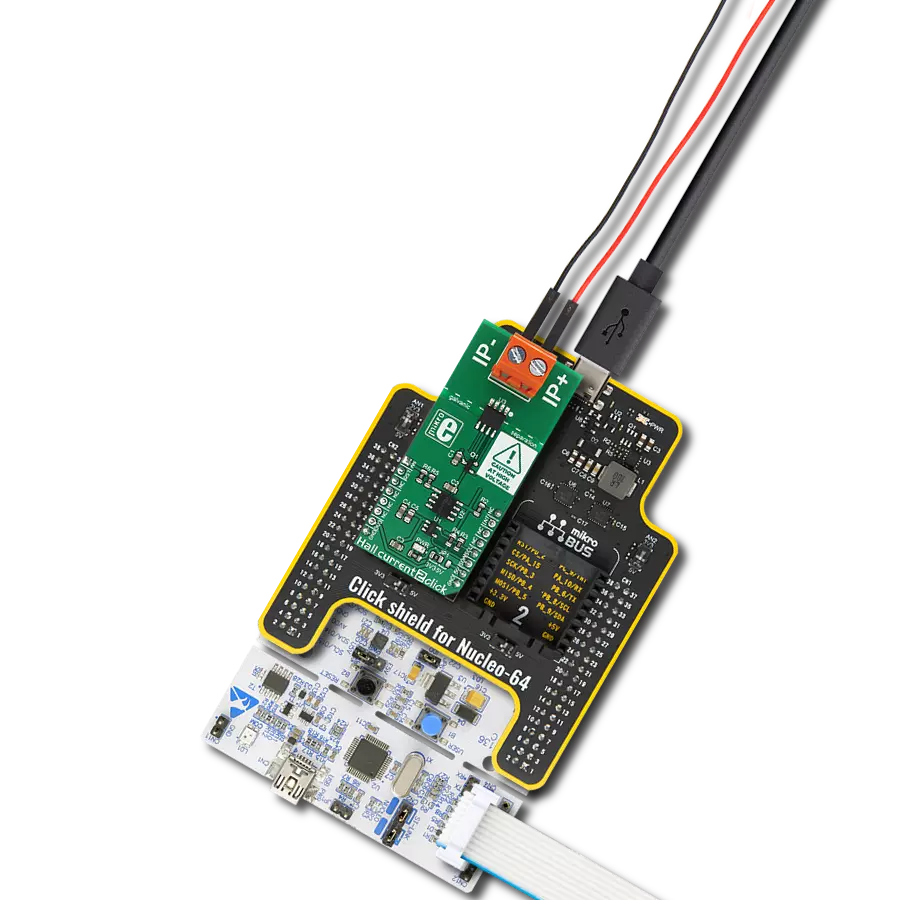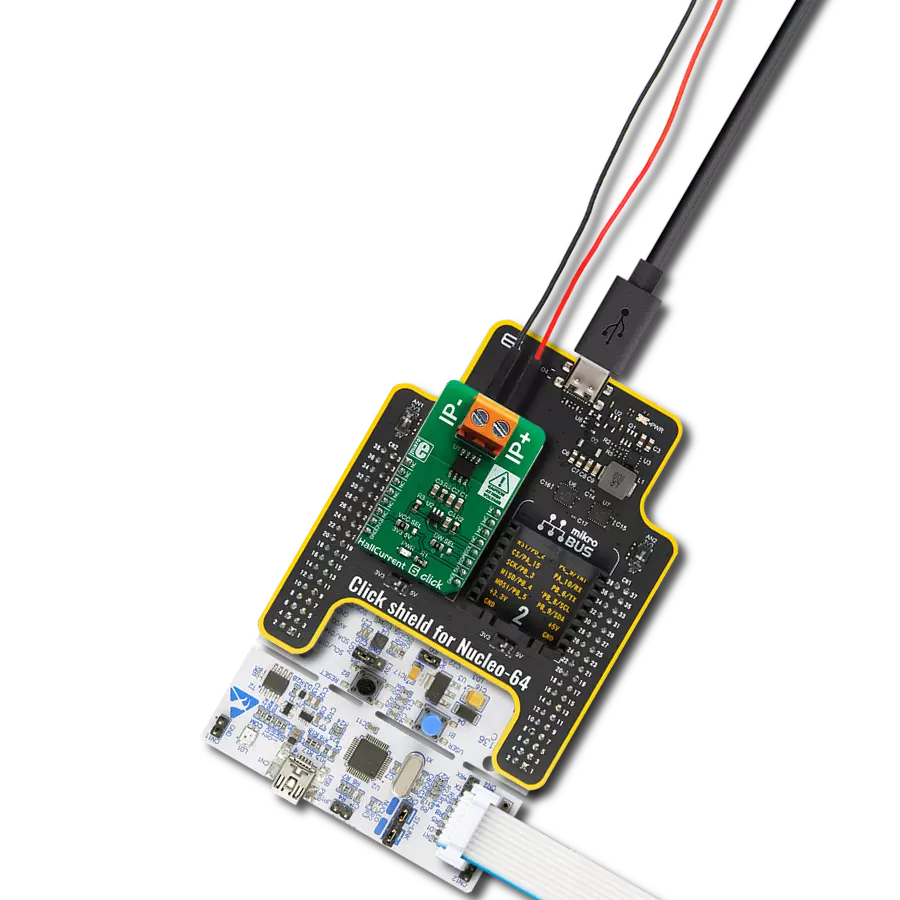Harness our advanced AC measurement solution to optimize power usage, enhance safety, and elevate efficiency across diverse applications
A
A
Hardware Overview
How does it work?
AC Current Click is based on the MCP607, a micropower CMOS operational amplifier from Microchip. The non-invasive sensor that should be used along this Click board™ works by utilizing the electromagnetic induction phenomenon, similar to a transformer. The primary coil does not exist, though; the electromagnetic field is generated by the AC Current running through the cable, which is measured. The core of the sensing probe is split, allowing it to clamp on the current conducting cable. Since the sensor does not influence the measurement circuitry in any way while being galvanically isolated simultaneously, it is an ideal solution to measure current running through mains or similar high-voltage installations. Note that only the AC current can be measured since the DC current cannot generate the alternating magnetic field, so the sensor can only be used for the AC current measurement. The Click board™ comes equipped with the 3.5mm jack connector, which is used to attach the sensing probe. The sensor input is filtered and amplified over the MCP607 so that the readings can stay reliable and protected against EMI and radio interference. The reference voltage for the conversion is 2.048V, and the MAX6106, a voltage reference from Analog Devices
provides it. It samples the input voltage generated by the contactless, non-invasive current sensor attached to the 3.5mm jack connector. This allows a minimal distortion of the input. The amplification ratio (G) is calculated using the non-inverting operational amplifier configuration formula: G = 1 + R4 / R3. Knowing the maximum voltage of the sensor (for 10A current), the reference voltage of 2.048V for the ADC, and the gain factor of the op-amp, it is easy to calculate the value for the measured current. The Click board™ comes with library functions that do all the necessary calculations, providing a simple and quick solution for application development. A user can also easily develop his methods and functions using existing ones if some other sensor with different nominal values is used. However, this Click board™ also comes as part of the AC Current click - bundle, which also contains the current measuring sensor calibrated and well suited to work with the AC Current click (10A - 1V). AC Current Click uses a standard 3-Wire (read-only) SPI serial interface of the MCP3201 to communicate with the host MCU. Besides the onboard A/D converter, an analog signal path is available to the users, allowing the board™ to fit into various usage scenarios. Besides
the onboard ADC, it is possible to use an external converter by using the AN pin of the mikroBUS™. The preconditioned voltage from the first (non-inverting) operational amplifier is routed to the onboard ADC and another op-amp, which acts as the buffer with unity gain. It provides a buffered analog voltage at the AN pin, which can be used externally, bypassing the onboard ADC. The MCP607 consists of two integrated op-amps, so the same IC is used both for the input preconditioning and the output buffer. Note that although the Click board™ is meant to measure current without making contact using a galvanically isolated sensor over an isolated cable, special care should always be taken when working with dangerous voltages. Any operation which involves high voltage should be performed by trained personnel. This Click board™ can operate with either 3.3V or 5V logic levels selected via the VCC SEL jumper. This way, both 3.3V and 5V capable MCUs can use the communication lines properly. Also, this Click board™ comes equipped with a library containing easy-to-use functions and an example code that can be used, as a reference, for further development.

Features overview
Development board
Nucleo-64 with STM32F446RE MCU offers a cost-effective and adaptable platform for developers to explore new ideas and prototype their designs. This board harnesses the versatility of the STM32 microcontroller, enabling users to select the optimal balance of performance and power consumption for their projects. It accommodates the STM32 microcontroller in the LQFP64 package and includes essential components such as a user LED, which doubles as an ARDUINO® signal, alongside user and reset push-buttons, and a 32.768kHz crystal oscillator for precise timing operations. Designed with expansion and flexibility in mind, the Nucleo-64 board features an ARDUINO® Uno V3 expansion connector and ST morpho extension pin
headers, granting complete access to the STM32's I/Os for comprehensive project integration. Power supply options are adaptable, supporting ST-LINK USB VBUS or external power sources, ensuring adaptability in various development environments. The board also has an on-board ST-LINK debugger/programmer with USB re-enumeration capability, simplifying the programming and debugging process. Moreover, the board is designed to simplify advanced development with its external SMPS for efficient Vcore logic supply, support for USB Device full speed or USB SNK/UFP full speed, and built-in cryptographic features, enhancing both the power efficiency and security of projects. Additional connectivity is
provided through dedicated connectors for external SMPS experimentation, a USB connector for the ST-LINK, and a MIPI® debug connector, expanding the possibilities for hardware interfacing and experimentation. Developers will find extensive support through comprehensive free software libraries and examples, courtesy of the STM32Cube MCU Package. This, combined with compatibility with a wide array of Integrated Development Environments (IDEs), including IAR Embedded Workbench®, MDK-ARM, and STM32CubeIDE, ensures a smooth and efficient development experience, allowing users to fully leverage the capabilities of the Nucleo-64 board in their projects.
Microcontroller Overview
MCU Card / MCU

Architecture
ARM Cortex-M4
MCU Memory (KB)
512
Silicon Vendor
STMicroelectronics
Pin count
64
RAM (Bytes)
131072
You complete me!
Accessories
Click Shield for Nucleo-64 comes equipped with two proprietary mikroBUS™ sockets, allowing all the Click board™ devices to be interfaced with the STM32 Nucleo-64 board with no effort. This way, Mikroe allows its users to add any functionality from our ever-growing range of Click boards™, such as WiFi, GSM, GPS, Bluetooth, ZigBee, environmental sensors, LEDs, speech recognition, motor control, movement sensors, and many more. More than 1537 Click boards™, which can be stacked and integrated, are at your disposal. The STM32 Nucleo-64 boards are based on the microcontrollers in 64-pin packages, a 32-bit MCU with an ARM Cortex M4 processor operating at 84MHz, 512Kb Flash, and 96KB SRAM, divided into two regions where the top section represents the ST-Link/V2 debugger and programmer while the bottom section of the board is an actual development board. These boards are controlled and powered conveniently through a USB connection to program and efficiently debug the Nucleo-64 board out of the box, with an additional USB cable connected to the USB mini port on the board. Most of the STM32 microcontroller pins are brought to the IO pins on the left and right edge of the board, which are then connected to two existing mikroBUS™ sockets. This Click Shield also has several switches that perform functions such as selecting the logic levels of analog signals on mikroBUS™ sockets and selecting logic voltage levels of the mikroBUS™ sockets themselves. Besides, the user is offered the possibility of using any Click board™ with the help of existing bidirectional level-shifting voltage translators, regardless of whether the Click board™ operates at a 3.3V or 5V logic voltage level. Once you connect the STM32 Nucleo-64 board with our Click Shield for Nucleo-64, you can access hundreds of Click boards™, working with 3.3V or 5V logic voltage levels.
The AC Current sensor is a non-invasive device designed for measuring alternating current. This split-core sensor can easily clip around live or neutral wires, making it versatile for various applications. It finds utility in the current measurement, monitoring, and protection of AC motors, lighting equipment, and air compressors. Key features of this sensor include an open size of 13mm x 13mm, a leading wire length of 1m, and a dielectric strength of 1000V AC/1min 5mA between the shell and output. It operates within a temperature range of -25°C to +70°C, adhering to a resistance grade of Grade B. The built-in sampling resistance (RL) is 186Ω, boasting a non-linearity of ±3%. The output mode ranges from 0 to 1V, accommodating input currents from 0 to 10A AC. With a fire resistance property in accordance with UL94-VO, this AC Current sensor ensures reliable and safe current monitoring in diverse electrical applications.
Used MCU Pins
mikroBUS™ mapper
Take a closer look
Click board™ Schematic

Step by step
Project assembly
Software Support
Library Description
This library contains API for AC Current Click driver.
Key functions:
accurrent_get_a- Gets current value of AC Current in Aaccurrent_get_ma- Gets current value of AC Current in mA.
Open Source
Code example
The complete application code and a ready-to-use project are available through the NECTO Studio Package Manager for direct installation in the NECTO Studio. The application code can also be found on the MIKROE GitHub account.
/*!
* \file
* \brief AcCurrent Click example
*
* # Description
* This application measures AC current through a conductor.
*
* The demo application is composed of two sections :
*
* ## Application Init
* SPI driver and Click initialization.
*
* ## Application Task
* Reads the value of AC current and displays it on the USB UART.
*
* ## NOTE
* An appropriate AC Current sensor needs to be connected to the Click board.
*
* \author MikroE Team
*
*/
// ------------------------------------------------------------------- INCLUDES
#include "board.h"
#include "log.h"
#include "accurrent.h"
// ------------------------------------------------------------------ VARIABLES
static accurrent_t accurrent;
static log_t logger;
void application_init ( void )
{
log_cfg_t log_cfg;
accurrent_cfg_t cfg;
/**
* Logger initialization.
* Default baud rate: 115200
* Default log level: LOG_LEVEL_DEBUG
* @note If USB_UART_RX and USB_UART_TX
* are defined as HAL_PIN_NC, you will
* need to define them manually for log to work.
* See @b LOG_MAP_USB_UART macro definition for detailed explanation.
*/
LOG_MAP_USB_UART( log_cfg );
log_init( &logger, &log_cfg );
log_info( &logger, "---- Application Init ----" );
// Click initialization.
accurrent_cfg_setup( &cfg );
ACCURRENT_MAP_MIKROBUS( cfg, MIKROBUS_1 );
accurrent_init( &accurrent, &cfg );
}
void application_task ( void )
{
float ac_current = 0;
ac_current = accurrent_get_ma( &accurrent );
log_printf( &logger, "Current value: %.3f mA\r\n", ac_current );
Delay_ms ( 1000 );
}
int main ( void )
{
/* Do not remove this line or clock might not be set correctly. */
#ifdef PREINIT_SUPPORTED
preinit();
#endif
application_init( );
for ( ; ; )
{
application_task( );
}
return 0;
}
// ------------------------------------------------------------------------ END
Additional Support
Resources
Category:Current sensor



































